Wild boars are curious and playful, sometimes hungry, and they cause damages in the forests
The wild boar is native European species that finds suitable conditions for life in the current landscape of Central Europe. Its natural regulatory mechanisms are severely limited, in connection with global climate change and the absence of predation pressure from large animals. The high number of wild boars leads to a number of serious economic, biological and social consequences.
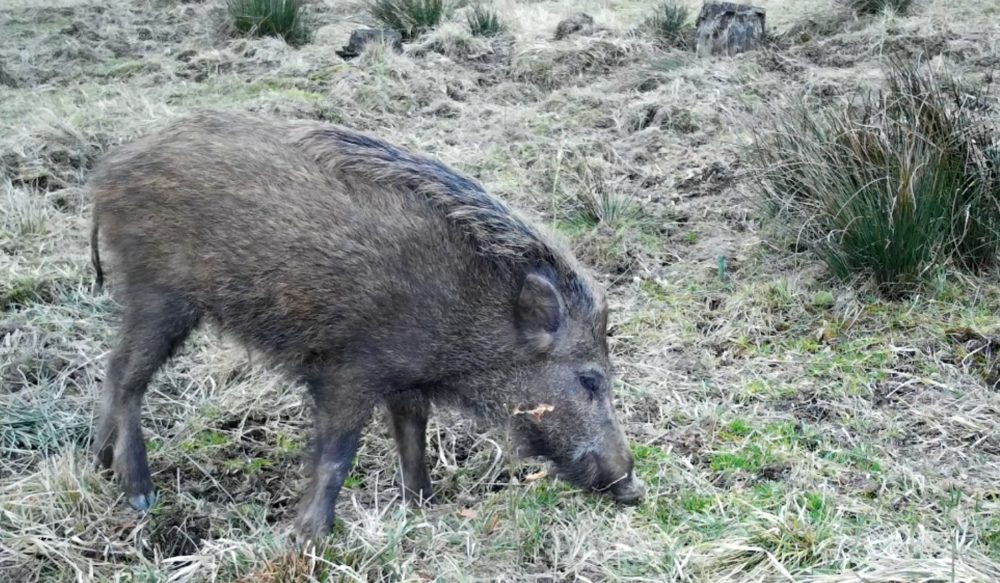 Photo: Wild boar uprooting seedlings of deciduous tree species, FGMRI (VÚLHM) archive
Photo: Wild boar uprooting seedlings of deciduous tree species, FGMRI (VÚLHM) archive
In recent years, there have been increasing numbers of areas in forests where large populations of wild boars significantly affect the success of forest regeneration and cause significant economic losses.
In 2019, damages to forest stands caused by wild boars amounted to CZK 75 million, in the Czech Republic. However, only the value of the planting material is included in this amount. The real damages, which also include the loss of wood production and other functions of the forest, including the unnecessarily spent costs for afforestation and the protection of seedlings, are therefore significantly higher.
Wild boars in higher numbers can consume all the fallow of attractive seeds (e.g. oaks, etc.) during the winter, thus preventing the natural regeneration of the stands. Other damage to forest stands is caused both by browsing of young trees and the abrasion of trunks and root growths. Other indirect damages in forests are also significant, such as damage to fencing or plantings, the surface of forest roads, etc.
Regarding to the current collapse of spruce forest stands in Central Europe and the need to restore forests on huge areas, the importance of another harmful effect of the wild boar, consisting in the systematic destruction of planted seedlings, is also increasing. Young small trees are most vulnerable during the first years after planting.
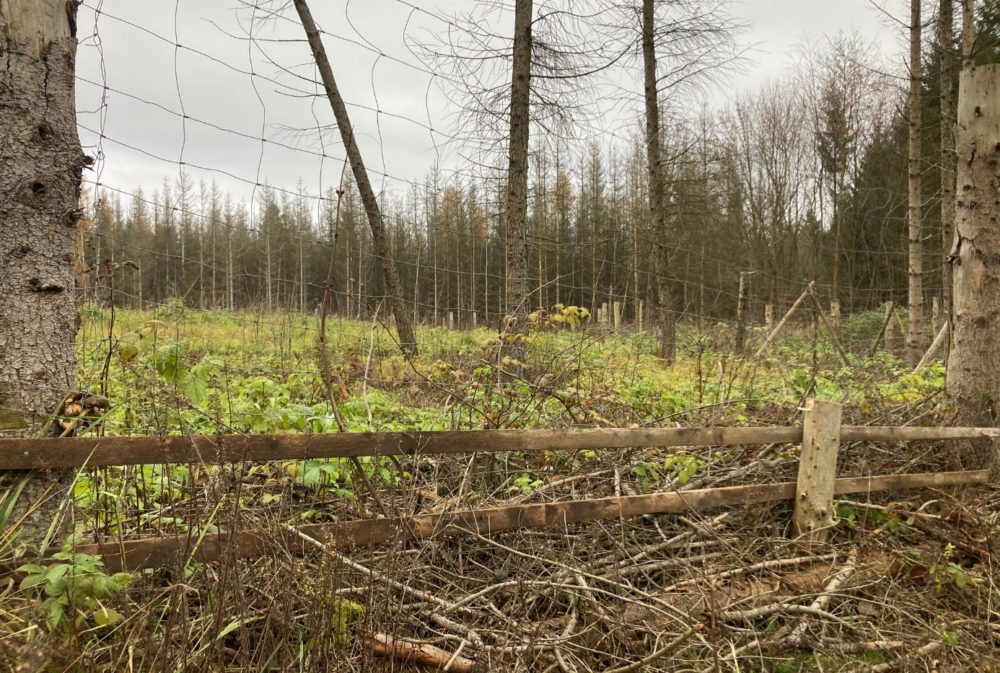 Photo: Detail of an effective but expensive wire fencing with wooden reinforcement against wild boars, FGMRI (VÚLHM) archive
Photo: Detail of an effective but expensive wire fencing with wooden reinforcement against wild boars, FGMRI (VÚLHM) archive
Although this behaviour of wild boars has been known for a long time, it practically did not occur. But, just in recent years it has appeared on a significant scale in some places. Damage caused by the wild boar was thus assigned to other factors complicating the restoration of forest stands, such as reduced viability of seedlings due to lack of precipitation, freezing, or browsing by wildlife.
Wild boars are most damaging to newly planted seedlings, pulling or uprooting them and sometimes nibbling on the roots. In other times they are leaving seedlings lying around without being eaten.
Due to the difficulty of predicting the risk of damage and the non-existing methods of protection, it is important to clarify the factors that motivate wild boars to damage seedlings and also verify the possibilities of protecting plantings in order to limit the effects of wild boars’ behaviour on forest ecosystems.
Scientists from the Opočno Research Station, VÚLHM, v. v. i., and Mendel University in Brno devoted themselves to the study of this problem. On the basis of the knowledge gained, they prepared for practice the Methodology of preventive measures against damage by wild boars on tree seedlings (Metodika preventivních opatření proti škodám prasetem divokým na sazenicích dřevin).
The aim of their research was to analyse the factors influencing the risk of damage to tree plantations by wild boars and to propose practically applicable methods of preventive and protective measures.
The methodology also deals with the evaluation of the current significance of these damages, with a description of the behaviour of wild boars when damaging forest trees, as well as with the dynamics of the occurrence of damages during the year, including the influence of the environment, which increases the risk of damages.
Part of the methodology is devoted to instructions for measures that effectively reduce the risk of damage, including economic evaluation and profitability.
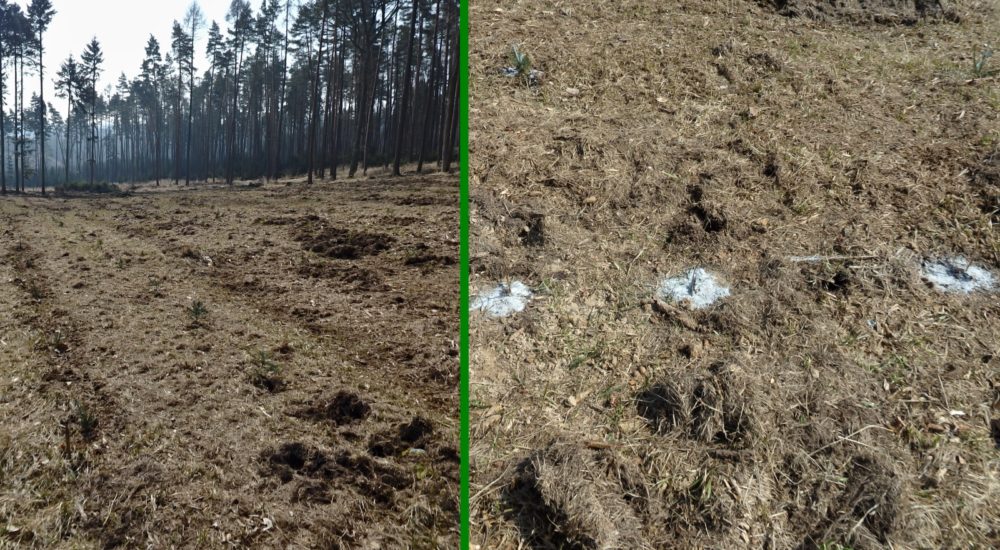 Photo: Cleared area with crushed brush, where engraving from wild boars is visible, and planting treated with calcium carbide repellent on the same area, FGMRI (VÚLHM) archive
Photo: Cleared area with crushed brush, where engraving from wild boars is visible, and planting treated with calcium carbide repellent on the same area, FGMRI (VÚLHM) archive
Scientists have found that the damage caused by wild boars to plantings has two or three main causes – hunger and curiosity or playfulness.
In the first case, wild boars are concerned with obtaining food, when they use seedlings as an emergency source of nutrients. Thus, the damage is caused by the hunger of wild boars, which pulls out or digs up the seedlings and consumes the roots along with the substrate.
Seedlings damaged by this way have bitten roots, which the wild boars thoroughly chew and then spit out the remains on the soil surface. This is an uncommon cause of damage that only occurs to a limited extent. These damages most often occur at the end of winter and in spring, when other sources of food are limited.
The second, respectively the third type of damage arises from the wild boars’ natural ability to explore the ground combined with their curiosity and playfulness (non-targeted damage). Such behaviour can appear anywhere and it does not matter whether the wild boars have an excess or a lack of food.
This type of damaging is most often visible just after planting, when the wild boars go to explore the freshly loosened soil. In this case, they are more or less not interested in the seedlings, which damage is mainly caused by accidentally digging seedlings up while digging through the loosened soil and let them lying undamaged.
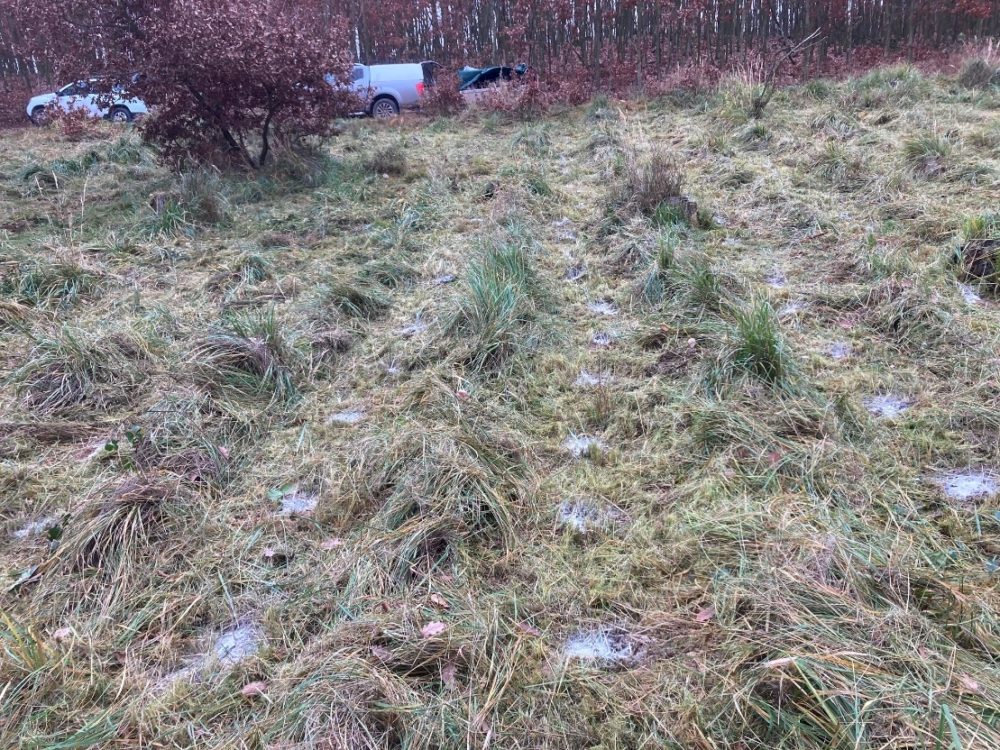 Photo: Site treated with calcium carbide-based powder repellent, FGMRI (VÚLHM) archive
Photo: Site treated with calcium carbide-based powder repellent, FGMRI (VÚLHM) archive
Based on the knowledge of the mechanism of wild boars’ motivation to such behaviour, scientists clarify in the methodology factors influencing the risk of damage and propose preventive measures that can significantly reduce the risk of damages.
Another aspect that was clarified thanks to the solution of the project is the fact that the uprooting of forest tree species’ seedlings by wild boars has no connection with the substrate or the method of planting. The reason for the uprooting is not even the root system itself, as the planted willow twigs were damaged more than classic seedlings.
In forestry practice, this type of damage has not been solved yet, mainly because of their small extent, being predicted with difficulties. The occasional uprooting of the seedlings was repaired at a tolerable cost, and there was no need to look for and apply any special measures. For that reason, this problem has been neglected and there is a lack of both a detailed analysis of the causes of this wild boars’ behaviour and instructions on practical steps to limit the damages.
The proposed methodology fills this gap and it is giving to forestry practice a tool with the help of which it is possible to choose an appropriate procedure for reducing losses caused by wild boars on forest tree species’ plantings.
A fundamental innovation is the design of new repellents containing calcium carbide, which are characterized by high efficiency, easy application and with favorable price.
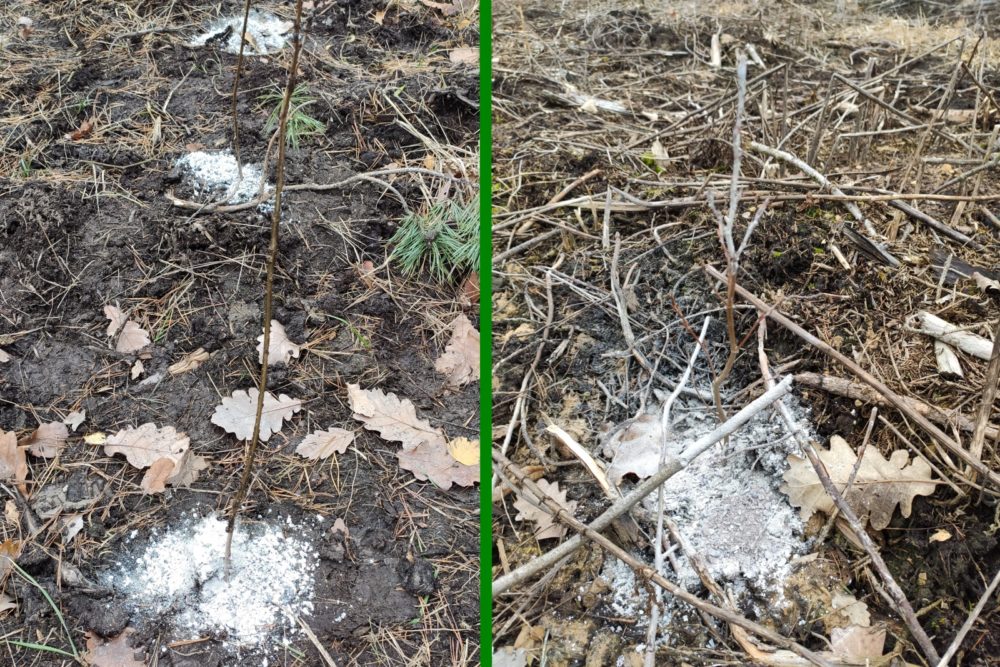 Photo: Application of 30 g of a preparation based on calcium carbide on the soil surface in the area of the root neck of planted seedlings (experimental plots under forest owners’ management).
Photo: Application of 30 g of a preparation based on calcium carbide on the soil surface in the area of the root neck of planted seedlings (experimental plots under forest owners’ management).
The researchers have verified the effectiveness of the carbide itself at the recommended dose of 30 g per seedling, or by the use of fertilizers containing carbide at a dosage of 30 g of the active substance per seedling. Fertilizers, in addition to their repellent effect, also improve soil conditions, which are essential for the growth of forest tree species seedlings.
The methodology was created as part of the solution of the project “Tools and measures for minimizing damage to the roots of nursery plantings after their planting by wild boars” (TH04030444).
Methodology of Preventive Measures Against Wild Boar Damage to Tree Seedlings (Metodika preventivních opatření proti škodám prasetem divokým na sazenicích dřevin) can be downloaded here.
Authors of methodology Ing. Vlastimil Skoták; prof. Ing. Jiří Kamler, Ph.D.; Ing. Jarmila Nárovcová, Ph.D.; Ing. Václav Nárovec, CSc.; Ing. Dušan Kacálek, Ph.D.; Ing. Milan Coufal; Ing. Ivo Machovič
Prepared by: Ing. Jan Řezáč, e-mail: rezac@vulhm.cz
